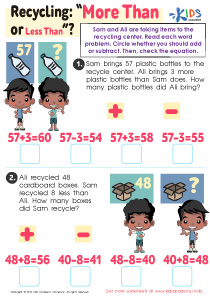Practicing subtraction Place Value Worksheets for Ages 4-9
3 filtered results
-
From - To
Enhance your child’s math skills with our engaging subtraction place value worksheets designed specifically for ages 4 to 9. These worksheets help young learners grasp the fundamentals of subtraction while deepening their understanding of place value concepts. Featuring colorful graphics and interactive exercises, each worksheet fosters critical thinking and problem-solving abilities. Whether your child is just starting or needs extra practice, our resources cater to various skill levels, making learning enjoyable and effective. Empower your child’s mathematical journey today with our comprehensive subtraction worksheets, perfect for home or classroom use. Discover the fun in math while building essential skills!


Trading Tens for Equal Value Worksheet: Part 1


Place Value Thousands Worksheet


Trading Tens for Equal Value Worksheet: Part 2
Practicing subtraction and place value is crucial for children aged 4-9, as these foundational skills serve as the building blocks for more complex mathematical concepts. Understanding place value helps children grasp the significance of digits in a number based on their position. This knowledge is vital when performing subtraction, as it allows them to comprehend the borrowing process and avoid common errors that can arise during calculations.
Moreover, strong skills in subtraction enhance children's problem-solving abilities and boost their confidence in math. By integrating place value into subtraction exercises, parents and teachers can promote a deeper understanding of numerical relationships and improve computational fluency. These skills are not only essential for academic success but are also practical tools that children will utilize throughout their lives.
Engaging in regular subtraction practice promotes critical thinking and develops perseverance, as children learn to tackle challenges methodically. Moreover, this practice nurtures a positive attitude toward mathematics, encouraging a lifelong love for learning. In the long run, strong foundational skills in place value and subtraction contribute to overall mathematical competence, paving the way for future academic achievements and fostering essential life skills. Therefore, parents and teachers should prioritize these practices in educational settings.

 Assign to My Students
Assign to My Students
















